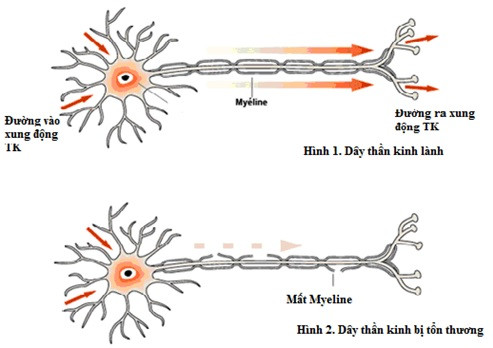Spasticity immediately by Guillain - Barré syndrome
After about one week of diarrhea, male patients with weakened limbs, loss of tendon reflexes, doctors identified Guillain - Barré syndrome, ie nerve root inflammation.
Doctor Le Tran Vinh, Head of Neurology Department, Thu Duc District Hospital, said patients were hospitalized with numbness in the hands and feet, sensory disorders, loss of muscle tendon reflexes. Symptoms are gradually increasing, only a few days after the patient paralyzed nerves number 7 on both sides, distorted face, paralytic pharyngeal muscles could not swallow, weakened limbs.
Results of cerebrospinal fluid and electromyography determine patients with Guillain syndrome - Barré , a rare disorder in which the immune system attacks the nerves. The patient is indicated for treatment with a blood change in plasma in the isolation room. Patients must have mechanical ventilation, feeding through the stomach with good nutrition. After 4 times of changing plasma, patients are gradually recovering. According to the treating doctor, if the patient passes the emergency, the patient is expected to take several months to monitor treatment.

In this pathology, the immune system directly resists peripheral nerves, most often myelinated nerves.
According to Dr. Vinh, Guillain - Barré syndrome is an autoimmune disease affecting peripheral nerves. The cause is still unknown. About 60% of patients have respiratory or gastrointestinal infections before developing the disease. It can also occur after several vaccines such as swine flu, polio, rabies, meningococcal meningitis; After surgery the head, chest, abdomen and limbs.
Neurological symptoms appear on average 1-2 weeks after incidents. Common manifestations are muscle weakness, facial paralysis, sensory abnormalities, loss of muscular tendon reflexes, dysuria, urinary retention, functional bowel or paralysis. Patients may also be dizzy or faint when sitting up due to low blood pressure, pulse-type headache due to hypertension, palpitations due to tachycardia or irregular heartbeat, cold hands and feet, increased sweating, and excessive mixed or convulsed .
This is a serious disease, the patient can die if not diagnosed and treated promptly. If diagnosed early, treated and cared for properly, the patient is likely to recover well. There are two main treatments: plasma replacement or intravenous immunoglobulin.
The cause of death is often caused by complications such as plant neurological disorders, acute respiratory failure, pneumonia, pulmonary embolism. The recovery rate of patients varies depending on the site but progresses steadily. After treatment, patients recover often for several weeks, months or longer if axon degeneration occurs.
- Zika virus is the culprit causing dangerous neurological syndrome
- Paralyzed after being bitten by a mosquito
- The disease syndrome makes people special
- Strange fear syndrome that you may be suffering from but don't know how to call
- Zika virus detection causes brain disorders in adults
- Fake crocodiles to study
- She has a higher IQ than Einstein and Stephen Hawking
- Decode the 10 most macabre mental diseases that people have
- Detection of Down syndrome when the fetus is only 11 to nearly 14 weeks old
- Dishwashing rags can cause paralysis
- The truth about human 'unusual' eating syndrome
- What is IBS syndrome?
 Green tea cleans teeth better than mouthwash?
Green tea cleans teeth better than mouthwash? Death kiss: This is why you should not let anyone kiss your baby's lips
Death kiss: This is why you should not let anyone kiss your baby's lips What is salmonellosis?
What is salmonellosis? Caution should be exercised when using aloe vera through eating and drinking
Caution should be exercised when using aloe vera through eating and drinking